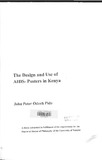| dc.description.abstract | The hypothesis of this study is that differences in aesthetic and communication
systems confound the efficacy of posters used in efforts to control IDV-AIDS in Kenya.
The study is based on empirical observation of the apparent failure of AIDS education
campaigns to influence risk-taking behavior. Applying the theories and principles of
design education as a filter and an analytical tool, the study takes into account the models
and practice of several disciplines including communication, health education and health
care delivery.
The lack of substantial success of the health education approach, in general, and
posters, in particular in curbing AIDS in Kenya invites questions on the efficacy of
posters as a medium of communication. The study focuses on the poster, and in so ,
doing takes into account various parameters including perception of disease, sexuality,
and design for health education as well as aesthetics and communication systems. Using
archival data, relevant literature in several disciplines, participant observation as well as
qualitative and quantitative analysis of data gathered in the field, the study established
that conflicts among various models impact negatively on the efficacy of posters
rendering them more or less ineffective in the campaign against AIDS.
The field sample consisted of seventy eight users of posters and eleven health
Workers in Kisumu who were interviewed to find out their opinions on the effectiveness
of posters in the fight against AIDS. In general, the concerned users think that posters
are not effective in controlling HIV infection and the spread of AIDS in Kenya. A few selected posters were analyzed with views to advancing recommendations for
improving on the design of AIDS-posters and heal the education in general.
The conclusion of the archival, experiential and observational components of this
study coupled with the data gathered by report from a surveys ampleist hat posters are an
inappropriate and ineffective medium for communication about IDVIAIDS if the
objective of that communication is to slow down,or halt the spread of the virus. | en |

